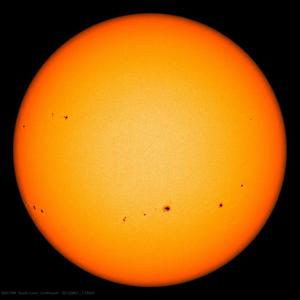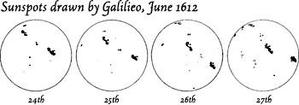Glossary term: Sunspot
Description: A sunspot is a temporary, cool region, caused by a strong magnetic field in the Sun's photosphere. Sunspots are areas where tubes of magnetic flux emerge from deeper in the Sun. The high magnetic field increases the magnetic pressure in these regions. To stay at the same pressure as their surroundings, the gas and plasma pressure in the sunspot must drop, making it cooler than its surroundings. As they are cooler than the surrounding photosphere, sunspots can be seen through a telescope as dark patches/blotches on the surface of the Sun. Sunspots range in size from tens of kilometers across to over a hundred thousand kilometers across. They can persist for timescales between a few days and a few months. The number and location of sunspots on the Sun varies over the solar cycle. Other stars are also thought to have spots caused by their magnetic fields.
Related Terms:
See this term in other languages
Term and definition status: This term and its definition have been approved by a research astronomer and a teacher
The OAE Multilingual Glossary is a project of the IAU Office of Astronomy for Education (OAE) in collaboration with the IAU Office of Astronomy Outreach (OAO). The terms and definitions were chosen, written and reviewed by a collective effort from the OAE, the OAE Centers and Nodes, the OAE National Astronomy Education Coordinators (NAECs) and other volunteers. You can find a full list of credits here. All glossary terms and their definitions are released under a Creative Commons CC BY-4.0 license and should be credited to "IAU OAE".
Related Media
Sunspots
Credit: NASA/SDO/HMI credit link
License: PD Public Domain icons
Related Activities
Measure the Sun's Rotation Period
astroEDU educational activity (links to astroEDU website) Description: Find out the Sun’s rotation period, applying the simple equation of average speed to a real astronomical case.License: CC-BY-4.0 Creative Commons Attribution 4.0 International (CC BY 4.0) icons
Tags: Hands-on , History , Experiment , Galileo , average speed Age Ranges: 16-19 Education Level: Secondary Areas of Learning: Social Research Costs: Low Cost Duration: 1 hour 30 mins Group Size: Group Skills: Analysing and interpreting data , Engaging in argument from evidence , Planning and carrying out investigations , Using mathematics and computational thinkingIs the Sun rotating? Follow the sunspots!
astroEDU educational activity (links to astroEDU website) Description: Like a "modern" Galileo, use true astronomical satellite observations to discover if the Sun (and other celestial objects) are rotating!License: CC-BY-4.0 Creative Commons Attribution 4.0 International (CC BY 4.0) icons
Tags: Hands-on , History , Experiment , Galileo Age Ranges: 12-14 , 14-16 , 16-19 Education Level: Middle School , Secondary Areas of Learning: Social Research Costs: Low Cost Duration: 1 hour Group Size: Group Skills: Analysing and interpreting data , Planning and carrying out investigations










